Fish and Wildlife Special Purpose Account annual report 2012–2013
The 2012-2013 annual report on the Ministry of Natural Resources' Special Purpose Account. This account houses all the licensing fees, royalties and fines collected under the Fish and Wildlife Conservation Act.
Cette publication hautement spécialisée Special Purpose Account Expenditure Report n’est disponible qu’en Anglais en vertu du Règlement 411/97 qui en exempte l’application de la Loi sur les services en français. Pour obtenir de l’aide en français, veuillez communiquer avec FLS Information Access Representative au ministère des Richesses naturelles et Forêts au NRISC@ontario.ca
Introduction
Ontario’s fish and wildlife resources are rich and diverse. The province has more than 250,000 inland lakes and thousands of kilometres of rivers and streams, extensive forests and wetlands across 4 ecological regions. These provide important habitat for more than 140 species of fish, 57 types of amphibians and reptiles, 85 species of mammals, 400 species of birds, numerous insects and other micro-organisms. This diversity contributes to our environmental, social, cultural and economic well-being.
Fishing and hunting are great ways to spend time together outdoors as a family. You can learn about the environment, strengthen family ties and connect with the natural world.
The province’s phenomenal fisheries can be enjoyed during all four seasons. While some of the most sought-after sport fish are walleye, yellow perch, northern pike, brook trout and lake trout, more anglers are learning to appreciate lesser-known species like carp, gar and black crappie.
Hunting has had a long history and tradition in Ontario. Residents and visitors alike take to the field each year to pursue a wide range of wildlife, including moose, deer, bear, wild turkey and other species. In addition to harvesting their own food, hunters play a key role in managing wildlife populations across the province.
MNR is committed to ensuring healthy fish and wildlife for years to come in Ontario. In 1995 the MNR established a separate account to serve as the financial mechanism to dedicate fish and wildlife revenue to fish and wildlife management. All licence fees, fines and royalties collected under the Fish and Wildlife Conservation Act (FWCA) are recorded in the Fish and Wildlife Special Purpose Account (F&W SPA) and applied to fish and wildlife management programs such as monitoring populations and enforcing regulations.
Fish and Wildlife Program expenditures are funded through a combination of F&W SPA and general revenues through the Consolidated Revenue Fund (CRF). Capital expenditures to support the program (i.e. vessels, vehicles, fish culture stations etc.) are funded solely through the CRF.
Pursuant to section 85.4 of the Fish and Wildlife Conservation Act, the Minister of Natural Resources is required to ensure that a report is prepared annually on the financial affairs of the Fish and Wildlife Special Purpose Account. This annual report of the 2012/2013 operational year provides an overview of the financial details and associated achievements delivered through the Fish and Wildlife Special Purpose Account.
Background
MNR is responsible for fish and wildlife management which includes policy, planning and program development / delivery, to sustain healthy fish and wildlife populations for years to come in Ontario. All activities funded through the F&W SPA are associated with one of the following service categories:
Population health, rehabilitation & enhancement
Population Health, Rehabilitation & Enhancement protects the sustainability of native fish and wildlife populations. These services include invasive species reporting, monitoring and control; fish and wildlife disease surveillance and response and; fish food safety programs. Fish Culture Services contribute to the genetic health of Ontario fisheries and contributes to increased angler and commercial fisheries success.
Species & scosystem science
Species and Ecosystem Science includes fish and wildlife population inventory monitoring and assessment as well as research relating to population, habitats and ecosystems in Ontario. State of the Resource Reports describe the condition, threats, trends and management response associated with specific areas, species, habitats or issues in Ontario.
Planning, solicy & segulatory services
Planning, Policy and Regulatory Services include development and implementation of resource management plans, policies, legislation, programs and standards related to recreational and commercial fisheries management and wildlife management in Ontario. Wildlife Management Units, Fisheries Management Zones and Great Lakes Management Units and their associated Council, public planning and engagement activities are included in this service category as well as the functions of public policy and legislation development in Ontario.
Conservation officers & enforcement
Conservation Officers and Enforcement Services safeguard the public interest by providing effective regulatory protection of Ontario’s natural resources, environment and public safety. MNRF maintains specialized units and services to support field enforcement, including a canine program, undercover and special investigations, and mobile offices in Conservation Officer vehicles.
Outdoors card & licensing
Outdoors Card and Licensing includes the issuance of hunting, sport fishing and commercial fishing licences, tags, draws and seals to resident and non-resident anglers, hunters and commercial fishers. This includes the operation of an automated licensing system and partnerships with Service Ontario and private businesses who sell licences on behalf of the Ministry.
Safety, education & promotion
Safety, Education and Promotion increases public awareness of the social, economic, health and lifestyle benefits of outdoor sport fishing and game hunting activities in Ontario. These services will engage the full diversity of Ontarians towards building a strong recreational fishing and hunting heritage. For example, the tenth annual Kid’s Fish Art Contest, a collaboration with the Ministry of Natural Resources and corporate partners, looks for winning artwork from Ontario students from grades 4 to 12. In 2012, students were to provide a drawing of either a Chinook salmon or longnose gar and a one-page essay depicting the species’ habitat and how to protect it for future generations. The Kid’s Fish Art Contest Winners for 2012 are:
Jessica Louise Kaercher Overall Winner
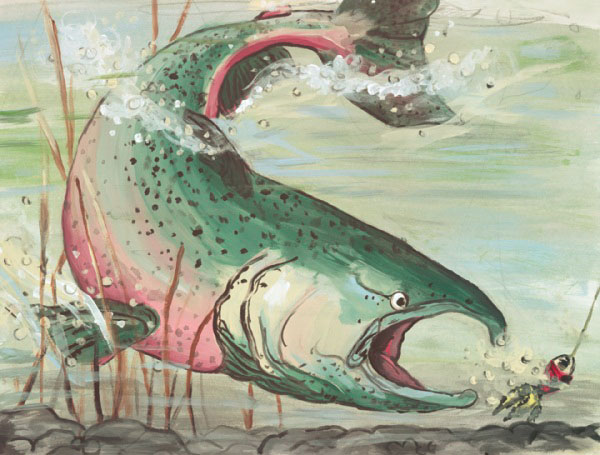
Jodie Brubacher Age 4-6 Category
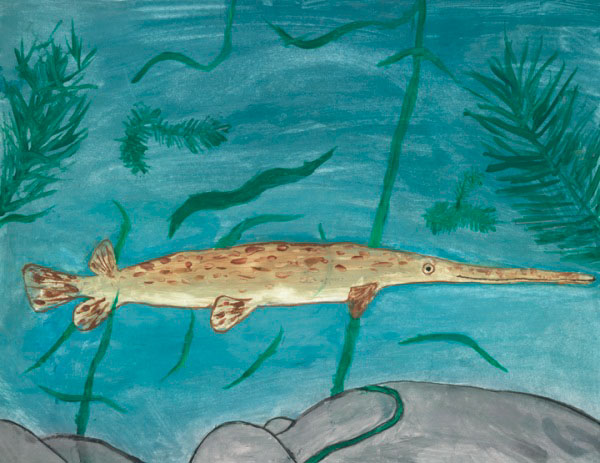
Yael Lebed Age 7-9 Category
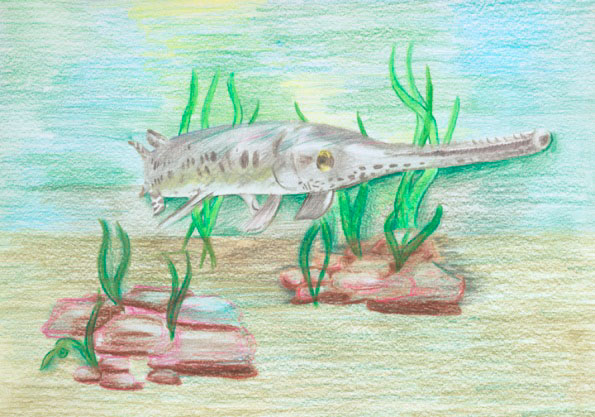
Legislation
The legislative basis for the Fish and Wildlife Special Purpose Account (F&W SPA) is contained within the Fish and Wildlife Conservation Act (SO 1997, c. 41) and is described as follows:
Special purpose account
- (1) All amounts received by the Crown under this Act shall be held in a separate account in the Consolidated Revenue Fund, including all fines, fees and royalties paid under this Act and all proceeds from sales under this Act, including sales of things forfeited to the Crown under this Act.
Money in account
(2) Money standing to the credit of the separate account is, for the purpose of the Financial Administration Act, money paid to Ontario for a special purpose.
Payments out of account
(3) The Minister may direct that money be paid out of the separate account to the Minister or a person specified by the Minister if,
- the payment will be used for the conservation or management of wildlife or fish populations or the ecosystems of which those populations are a part;
- the payment will be used for a matter related to the activities of people as they interact with or affect wildlife or fish populations, including any matter related to safety; or
- the payment will be used to refund all or part of a fee or royalty under subsection 83 (2).
Annual report
(4) The Minister shall ensure that a report is prepared annually on the financial affairs of the separate account, including a summary of advice received from any advisory committee established by the Minister relating to the operation of the separate account.
Tabling of report
(5) The Minister shall submit the report to the Lieutenant Governor in Council and shall table the report in the Legislative Assembly. 1997, c. 41, s. 85.
Fish and wildlife heritage commission
The Fish and Wildlife Heritage Commission (FWHC), established under the provisions of the Heritage Hunting and Fishing Act, provides recommendations on matters referred to it by the Minister. The FWHC consists of eleven members who represent a cross-section of key interests in the sustainable use of our fish and wildlife resources. The FWHC was active during 2012/2013 and reviewed materials and/or provided input on enhancement of the F&W SPA, and other initiatives such as the Elk and Moose Project, Disease Monitoring, Invasive Species Strategic Plans, F&W SPA Marketing Plan, and the Children’s Outdoor Charter.
Not all briefings and consultations led to specific recommendations for the Minister but in many cases the consultations helped to frame the final program or policy. The formal recommendations of the FWHC, and MNR’s response to the recommendations, are summarized in the following table.
| FWHC Recommendation | Ministry Response |
|---|---|
Recommendation #1:
|
|
Financial summary
The Fish and Wildlife Conservation Act (FWCA) requires that revenues collected under that Act flow into the Fish and Wildlife Special Purpose Account (F&W SPA). This includes all licence fees, royalties and fines paid under the FWCA and its regulations. Money held in this account may only be spent on:
- the conservation or management of wildlife or fish populations or the ecosystems of which those populations are a part;
- matters related to the activities of people as they interact with or affect wildlife or fish populations, including any matter related to safety; or
- a refund of all or part of a fee or royalty.
Fish and Wildlife Program expenditures are made from a combination of funds received from the F&W SPA and the Consolidated Revenue Fund (CRF) to provide for the delivery of an effective and diverse program. This report provides an overview of the financial results and achievements for the F&W SPA.
Revenue
Revenues deposited into the F&W SPA largely come from anglers, hunters and commercial users of fish and wildlife resources. Since the introduction of 3-year license products, the F&W SPA revenue cycle has traditionally reflected a high year of revenue followed by a medium and then low year. Of the total F&W SPA revenues:
- More than 90 percent comes from angling and hunting licences and permits.
- Of this, approximately two-thirds are associated with recreational fishing and one-third with hunting.
- About two-thirds of recreational licence revenues are derived from Ontario residents and about one-third from non-residents.
- Other revenue sources include fines collected under the FWCA, interest paid on the F&W SPA account and other miscellaneous sources such as product sales, and advertising.
Revenues ($000’s) to the Fish and Wildlife SPA over the past 3 fiscal years
| Source of Revenue | 2010/11 | 2011/12 | 2012/13 |
|---|---|---|---|
| Ontario Resident Angling and Hunting Licences and Permits | $55,614.9 | $42,939.1 | $36,293.9 |
| Non-Resident Angling and Hunting Licences and Permits | $15,743.3 | $16,450.0 | $19,531.5 |
| Commercial Fish Licences and Royalties | $1,122.4 | $1,328.0 | $1,026.7 |
| Bait Fish Licences | $319.5 | $304.7 | $297.8 |
| Fur Licences and Royalties | $730.1 | $861.0 | $1,178.9 |
| Fines and Penalties | $875.6 | $820.5 | $644.5 |
| Interest | $261.1 | $411.1 | $336.6 |
| Other Revenue | $364.8 | -$5.0* | $651.1 |
| Total Revenue | $75,031.7 | $63,109.4 | $59,961.0 |
* In 2011/12 there is a negative value in Other Revenue as a result of an accounting entry to correct prior year revenues.
Revenue forecast methodology
Historically, the Ministry of Natural Resources (MNR) has forecasted revenues from the sales of hunter, angler and commercial licences based on the most recent sales history with appropriate adjustments for fee changes. As part of this forecast methodology, MNR also estimates the ending cash balance to ensure sufficient operating revenues are available for future years.
Factors affecting recreational angling and hunting license and tag sales
A number of factors affect the level of sales of recreational angling and hunting licenses and tags. Among the most important are:
Population levels and economic conditions
Population levels and economic conditions can drive both short-term and long-term changes in sales. Economic conditions include levels of employment and personal income, and proportional amount of income that is available to be spent on recreational activities.
Resource conditions and access
Resource conditions (the abundance and availability of species important to anglers and hunters) also influence fluctuations in license sales. Better fishing opportunities create additional license sales. Wildlife researchers also indicate that limited access to hunting areas and game can decrease associated satisfaction and levels of participation.
Regulations
Regulations, which often depend on resource conditions, include such things as changes in seasons, bag limits, adoption of methods for rationing hunting tags (e.g. controlled hunt drawings), harvest quotas and legal harvest methods. Regulatory changes may increase or decrease the availability of fish and game to anglers and hunters.
Fee levels
Fee levels are an important determinant of the total level of revenue. The increases in fees approved in the past by the Ontario Legislature have had minimal adverse effects on numbers of licenses and tags sold to hunters and anglers.
Demographic and social factors
Demographic and social factors also affect participation in fishing and hunting. Such factors include population size and the composition of the population in terms of age, rural/urban residence, and family structure. Time available for recreational activities is also a factor as competition for leisure time and funding is intense. Access to hunting areas may be a significant factor influencing participation. Tastes and preferences for particular uses of fish and wildlife also may be changing.
Weather
Weather can be a significant influence on license and tag sales, either directly or indirectly. Weather and climatic conditions affect fish and wildlife survival rates, and hence the availability of the resources to the angler or hunter. Weather also can affect travel conditions and the ease with which fish or game can be found. The possibility of fire danger can lead to reduced availability of game through land closures.
Outlook for angling and hunting license and tag revenues
Analysis has shown that over time the sales of licenses have been declining as a percentage of total population. In the long run, changing demographics and social factors may result in a further decrease in sales of fishing and hunting licenses and tags.
The overall population is increasing at a moderate rate, but participation rates are declining. Ontario’s population is becoming more urbanized, with a greater number of alternative leisure activities. In addition, the population’s age composition is gradually changing toward a higher proportion of older people. Outdoor recreation participation rates generally tend to decline with age, and Ontario’s current license structure may result in sales being somewhat less than expected for a given population.
Resource conditions are notoriously hard to predict, as are individuals’ reactions to changes in regulations, so there is a fair degree of uncertainty associated with this aspect of the forecast. Sales of licenses and tags are dependent in large part on populations of various fish and wildlife species and access to those populations. The levels of fish and wildlife populations, in turn, are dependent on such variables as weather, disease, fire and predator populations.
Recoveries
Recovery/expenditure levels, revenues and the resulting F&W SPA account balance are reviewed annually as part of the program business planning cycle, and planned recoveries are adjusted as required. The program maintains a marginal year-end F&W SPA balance to allow for unexpected changes in future year revenue.
Annual recoveries from the F&W SPA are planned based on a 3-year rolling average of expected revenues, due to significant annual fluctuations resulting from the Outdoors Card 3- year purchasing cycle. Treasury Board approves the F&W SPA recovery level as part of the Ministry’s annual Results Based Plan submission.
The table below shows revenues and recoveries from the F&W SPA and resulting year-end F&W SPA balances for the past three fiscal years and the projected balance for the current fiscal year.
Summary of recoveries, revenues and year-end account balances ($000)
| Item | 2010/11 | 2011/12 | 2012/13 | 2013/2014 (Projected) |
|---|---|---|---|---|
| Year Start F&W SPA Balance | $15,046.6 | $25,586.9 | $21,139.9 | $12,523.1 |
| Revenues | $75,031.7 | $63,109.4 | $59, 961.0 | $74,708.4 |
| Recoveries/ Expenditures | ($64,491.4) | ($67,556.4) | ($68,577.7) | ($70,000.0) |
| Year End F&W SPA Balance | $25,586.9 | $21,139.9 | $12,523.1 | $17,231.6 |
Recoveries by service category
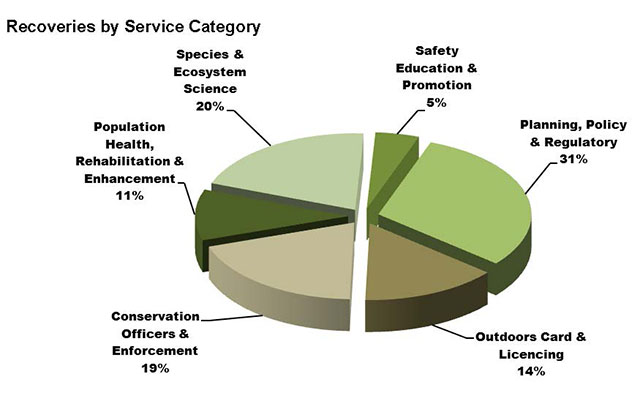
Fish and wildlife program expenditures
Operating expenditures for the Fish and Wildlife Program, including enforcement, amounted to $101.6 million in fiscal year 2012/13. Approximately 68% percent of these expenditures ($68.6 million) were supported by recoveries from the Fish and Wildlife SPA. The remaining $33.0 million in program expenditures were supported by funding from the CRF.
2012-13 Fish and wildlife program funding

Achievements
Each year the Ministry manages fish and wildlife populations and their habitats for long-term sustainability, undertakes recovery actions for species at risk, and improves recreational opportunities for angling, hunting and trapping. The following achievements section provides both detailed examples of a few initiatives undertaken by the Ministry, and as well as high level achievements by service category.
Initiatives in the spotlight
Black bear population monitoring in Ontario
In 2002, the Ministry of Natural Resources (MNR) established the Nuisance Bear Review Committee to review the nuisance bear issue in Ontario and prepare a report with recommendations. One of the recommendations was that MNR continue to investigate tools for monitoring the status of bears.
In response to the recommendation, the Ministry made a commitment to re-estimate the black bear population in the province to assess population levels and stability of the populations. In 2004, a new method to estimate the bear population in each Wildlife Management Unit (WMU) was implemented and the research was conducted over the following six years.
Bear Inside Hair Trap. photo: J.Connor
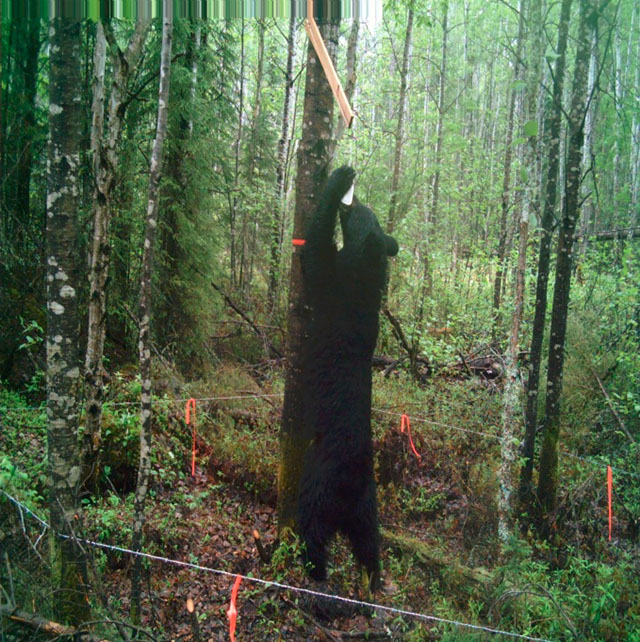
The new method, called Mark and Recapture using a DNA hair trap, is a method commonly used to estimate the size of wildlife populations. In the mark-recapture approach a sample of individual animals is captured, marked and then released unharmed back into the general population. The WMU estimates were based on the analysis of DNA in hair samples from bears, collected by an innovative hair-trap method, whereby black bear hair is collected at bait stations. This allowed the identification of individual bears from their genetic finger print.
Last year the Ministry was able to announce that this new research has enabled scientists to estimate the population of black bears in the province at approximately 95,000 bears +/- 10,000. This more statistically accurate estimate has confirmed that the provincial population of black bears has remained stable over the last 20 years.
Ontario’s Moose Project
Ontario’s moose population is generally healthy and continues to support world-class viewing and hunting opportunities each year. However, the population is experiencing some stressors and declines in certain locations. The MNR is being responsive and taking action towards sustaining a healthy moose population by launching the Moose Project across all of its range for the benefit of Ontarians for generations to come.
The Moose Project will implement Ontario’s new moose management policies. This includes a re-evaluation of the desired size of the moose populations across the province and how to best manage the moose harvest to achieve those desired levels. The Moose Project delivers on the ministry’s transformation efforts by further implementing a broad landscape approach to moose management as outlined in the Cervid Ecological Framework.
The MNR recently initiated the first phase of engagement on this project by conducting a socio- economic survey of resident moose hunters and releasing a series of Wildlife Management Unit level moose resource reports online (ontario.ca/moose) to provide the public with information on the current status and trends of moose populations, resident harvests and tag quotas across the province. A survey of resident moose hunters, and selected tourist outfitters in North East Region, was also conducted that complemented the provincial survey.
In 2013-14 the MNR is preparing to initiate additional outreach and engagement activities related to the Moose Project, including having direct discussions with stakeholders, Aboriginal groups and communities regarding draft population objectives and potential harvest management strategy options.
Moose. photo: JD Taylor
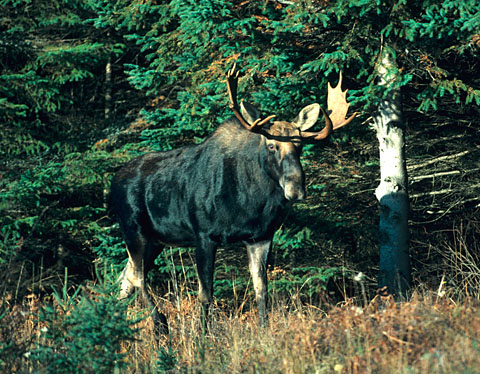
Normandale Fish Culture Station investment
The MNR fish culture program helps support a recreational fishery that is enjoyed by nearly 1.26 million licenced anglers annually. This fishery contributes approximately $2.26 billion to Ontario’s economy each year and provides approximately 41,000 person-years of employment. The fish culture program also stocks fish to conserve and restore biodiversity through the rehabilitation of native fish populations.
The Normandale Fish Culture Station, the oldest operating fish culture station in Ontario, plays an important role in the restoration of Atlantic Salmon to Lake Ontario, and in providing recreational fishing opportunities for Chinook Salmon and Rainbow Trout. The original main station was built in 1924 and was known as the Walsh Hatchery. The main station was rebuilt in 1964/65 and the advanced rearing building was added in 1984. The substation was built in 1934 nearby on Front Road and was rebuilt in 1959/60. Both facilities deteriorated over time and reached the end of their useful lives by about 2005.
The main station underwent an extensive rebuild including new wells and underground piping, new electrical service and a new building for rearing fish with office and support functions. An existing building was converted to a production-scale quarantine facility. The substation was completely rebuilt including a new dam at the head pond and a new building for maintenance of brood stocks (i.e. fish used for breeding). The total project, including detailed design, cost $18.5 million and was funded through the Consolidated Revenue Fund, however annual operational costs are funded through the F&W SPA.
With the new facilities, all of the production of Atlantic salmon and Chinook salmon for the Lake Ontario stocking programs is now being done at Normandale. MNR has rebuilt the main station and sub-station into state-of-the-art, enclosed facilities for early rearing, advanced rearing and brood stock facilities, specialized for the production of Atlantic Salmon. A production-scale quarantine facility has also been built for rearing Chinook Salmon. Rearing space has also been provided for other fish in the Salmon family, such as rainbow trout.
The new indoor facilities provide modern methods of reusing water to make more efficient use of available water; increased production capacity and increased flexibility for rearing multiple stocks.
In the future, a visitor centre will be added that will allow visitors to view the fish rearing facilities and to learn about fisheries management and fish species in Ontario.
Normandale Fish Culture Station photo: Dave Rosborough

Hatchery Tanks photo: Dave Rosborough
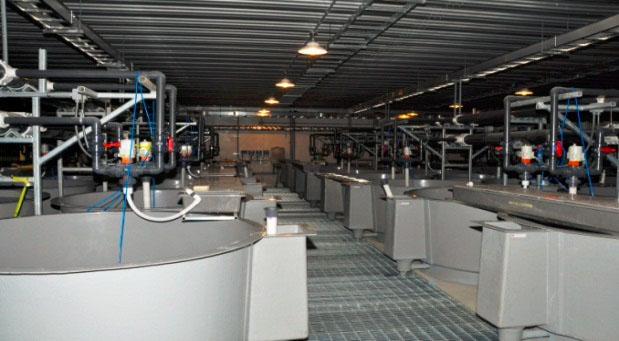
Population health, rehabilitation & enhancement
MNR is committed to ensuring fish and wildlife population health, rehabilitation and enhancement to protect the sustainability of native fish and wildlife populations. These services include invasive species reporting, monitoring and control; and fish and wildlife disease surveillance and response. Fish Culture Services contribute to the genetic health of Ontario fisheries and contributes to increased angler and commercial fisheries success. In 2012/2013 some of the achievements in this area include:
Monitoring
- Used the Lake Huron Lake Sturgeon Spawning Assessment to support the Species At Risk (SAR) recovery for this sensitive and rare fish. This assessment is being used to provide an indication of sturgeon population health, fish abundance and biology of the Nottawasaga Bay population to be used to develop biological indicators for other fish populations.
- Continued to evaluate the production of juvenile Lake Sturgeon including the study of juvenile and larval Sturgeon abundance, movement and habitat use and spawning success assessment in Lake Superior. In Lake Huron, twelve historically known or potential spawning rivers were assessed for juvenile Sturgeon production.
- Restoration efforts directed at Lake Superior Walleye populations continued with index netting surveys in Batchewana and Black Sturgeon bays. These surveys provide recreational fishery support and monitor the status of at-risk populations.
- Three recovering populations of Lake Trout were assessed in Lake Huron in the summer and fall of 2012. These surveys assess the success of stocking efforts, fish abundance, population characteristics and signs of successful survival and rehabilitation.
- Monitored Cisco in the St Mary’s River to collect biological measures of this potential donor stock to support Lake Huron cisco rehabilitation.
- Cisco stocks in western Lake Superior were assessed to aid in setting annual commercial quotas for the fishery. Annual recruitment is variable so over exploitation could collapse one of the last remaining healthy Cisco stocks in the Great Lakes.
- In support of coaster brook trout rehabilitation efforts, a near-shore Brook Trout assessment was conducted on Lake Superior. This involved electrofishing surveys in the Nipigon Bay area using standard protocol developed by the Lake Superior Technical Committee.
- Young-of-year Rainbow Trout assessments of the McIntyre and Current rivers provided information to assess special regulations and fishway success.
- An electrofishing assessment of Walleye was combined with collection of Chinook Salmon eggs in the Nipigon River. This allowed both the monitoring of walleye rehabilitation efforts and collection of Salmon eggs for the Thunder Bay Salmon Association hatchery.
- Evaluated trends in moose populations and harvests and assessed the current harvest management strategies for moose in Northeastern and Northwestern Ontario WMU’s and the relative need to consider changes in management direction. Public consultation on any potential changes in harvest management strategy options will follow in association with the Provincial Moose Project.
- Initiated a project to review factors influencing livestock predation by coyotes across Southern Ontario.
- Undertook research to improve understanding of use of habitat and movements across landscape in support of the sustainable management of martin, lynx, fisher, and wolverine.
- Waterfowl Banding: Long-term data collection to improve understanding of the distribution of Ontario’s waterfowl population. Provides important information in support of the North American Waterfowl Management Plan and manage breeding, migratory and wintering waterfowl habitat.
- Research conducted to identify Elk calving habitat in the Bancroft area to improve understanding of the role of site fidelity to calving success and inform future harvest and related management decisions.
- Conducted public workshops and outreach on hunting activities and land use practices to improve harvest allocations in areas with an over population of deer.
- Conducted fish population and fish habitat assessments and angler surveys on several Lake Trout lakes to determine the appropriate direction such as managing for natural populations, fish stocking or discontinuing active Lake Trout management. Summary reports were prepared and public consultation on proposed changes is planned for 2013/14.
- Worked in partnership with the Fisheries Management Zone Advisory Councils to set fisheries goals and objectives, contributing to the development of a fisheries management plan for the zone.
- Proposed updates to the Ontario Wetland Evaluation Systems Manuals and provided opportunity for public comment through the environmental registry.
Fish and wildlife disease surveillance and response
- Contributed to development of a national White-Nose Syndrome response plan for bats and collaborated on the development of a provincial action plan.
- Disease testing agreement established between Fish Culture and University of Guelph for wild fish and baitfish disease diagnostics and monitoring to support the fish culture program.
- MNR continued its surveillance of native cervid (deer, moose, elk) species for evidence of chronic wasting disease (CWD), sampling 488 white-tailed deer harvested by hunters during the 2012 hunting seasons. Since its inception in 2002, Ontario’s CWD surveillance program has tested over 9,400 animals, and no evidence of this debilitating disease has been found in Ontario wild cervid populations.
Invasive species reporting, monitoring and control
- Completed the third year of Aquatic Invasive Species (AIS) Monitoring in two high risk harbours in Lake Superior in support of the Lake Superior AIS Complete Prevention Plan. The project also involved the establishment of site specific survey protocol for monitoring these two high risk locations, and established a baseline for species presence.
- Initiated and developed an Asian Carp surveillance network including eDNA sampling and enhanced sampling methodologies.
- Delivered outreach activities including Operation Bait Bucket 2013 for invasive species messaging. Over 1000 winter anglers on Lake Simcoe were educated by crew members regarding proper disposition of leftover baitfish, how to report invasive species, and how to slow the spread of invasive species. Educational reference material was also provided.
- Research began to assess the ecological impact of bloody-red mysid (Hemimysis anomala) and Asian Carp, approaches to control round goby in the Great Lakes and develop tools for rapid response to invasive species.
Fish culture services
MNR operates 9 fish culture stations located strategically around the province to either rehabilitate degraded fish stocks and/or create/supplement recreational fishing opportunities.
The Fish Culture Section employs a 4 year production planning cycle by which clients submit their requirements for hatchery fish (or fish products such as eyed eggs) that allows for timely production planning, brood stock management, facility development planning, and efficient allocation and distribution of fish from provincial fish culture facilities.
Due to the variability of raising and caring for livestock, the Fish Culture Section strives to stock within +/- 5% of their clients’ stocking targets. In addition to the production numbers in the chart below the section maintains 18 brood stock lines of 12 different species of fish with developmental work currently underway on 1 new species and 2 new strains.
For more details on fish culture by species visit Ontario’s fish stocking program
Fish culture services fast facts:
| Activity | 2012/13 Target | 2012/13 Actual | % achieved | 2013/14 Target |
|---|---|---|---|---|
| Fish production for stocking into Great Lakes and inland lakes | 8,300,000 | 7,997,098 | 96% | 8,500,000 |
| Fish products (fertilized eggs and fry) for community hatchery partners for eventual stocking into public waters | 1,000,000 | 1,229,382 | 123% | 2,000,000 |
| Fish products (fertilized eggs, fry and some adult fish) for academic institutions and government agencies to support research | 471,500 | 550,000 | 117% | n/a |
| Fish products (fertilized eggs and fry) for commercial interests | n/a |
110,000 | n/a | n/a |
Atlantic Salmon Fry, photo: Brian Thompson
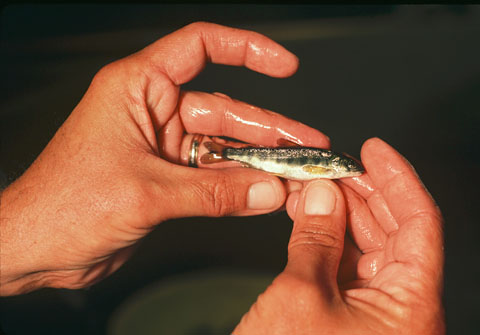
Fish Eggs, photo: Heather Bickle
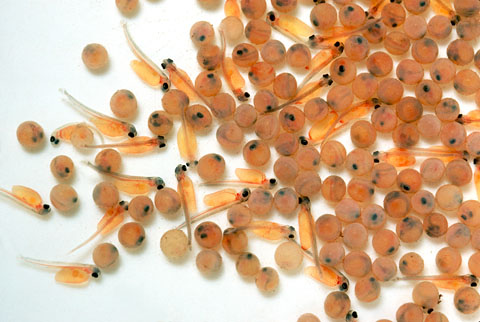
Conservation Officers & enforcement
An officer in the field, photo: Doug Hamilton
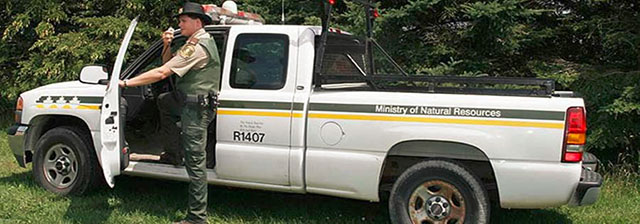
Conservation Officers and Enforcement Services safeguard the public interest by providing effective regulatory protection of Ontario’s natural resources, environment and public safety. MNR maintains specialized units and services to support field enforcement, including a canine program, undercover and special investigations, and mobile offices in Conservation Officer vehicles. Approximately 75% of Enforcement field activity is directed at Fish & Wildlife enforcement, however only 42% is funded by the F&W SPA.
The F&W SPA funded a portion of the following costs associated with Fish & Wildlife Enforcement: salary and benefits for Conservation Officers, Field Supervisors, and Intelligence and Investigations Specialists; fleet expenses (fuel, maintenance, and insurance); legal costs associated with prosecutions under the FWCA; charges for office space, telecommunications, and utilities at work locations for field enforcement staff; and machinery and equipment to support Fish & Wildlife enforcement, including all-terrain vehicles, snowmobiles, and small vessels.
Conservation Officers also conduct public outreach and education to increase awareness and knowledge and promote compliance with Ontario’s Fish and Wildlife Conservation Act. Public outreach is conducted through attendance at sportsmen shows, delivering presentations to children in schools and engaging the public through various other venues.
In 2012/13 the number of hours planned for outreach was 14,474 hours, and 14,739 hours were spent delivering outreach and education. The Ministry not only met the target for public outreach, but surpassed the target by almost 2%. For 2013/14 the Ministry has planned 14,604 hours of public outreach which continues to support the overall objective educating the public to increase compliance with Ontario’s Fish and Wildlife Conservation Act.
Enforcement fast facts:
In 2012/2013 the SPA funded:
- Over 122,000 Conservation Officer contacts
- More than 90,000 Conservation Officer hours in the field
- Over 4,000 warnings
- Over 2,700 charges
Planning, policy & regulatory services
Planning and Regulatory Services include development and implementation of resource management plans, policies, legislation, programs and standards related to recreational and commercial fisheries management and wildlife management in Ontario. Wildlife Management Units, Fisheries Management Zones and Great Lakes Management Units and their associated Council, public planning and engagement activities are included in this service category as well as the functions of public policy and legislation development in Ontario. Highlights of the achievements for 2012-2013 include:
Planning
- Approval of the Ontario Invasive Species Strategic Plan as a guiding policy framework to address potential and discovered invasive species in Ontario.
- Drafted preliminary Provincial Fish Strategy for public consultation.
- The MNR publicly released the government’s strategic action plan response titled “Biodiversity: It’s In Our Nature”.
- Initiated policy review and modernization of use and harvest of live bait for angling.
Policy
- As part of the ministry’s transformation plan, MNR modernized the delivery of 21 wildlife-related approvals issued under the Fish and Wildlife Conservation Act to provide faster and improved client services, reduce burden on individuals, business and government, and focus more closely on MNR’s core mandate. Examples of the changes include:
- Allowing groups to host fish and game charity dinners without getting approval from the ministry provided they follow rules set out in regulation.
- Allowing licensed hunters to assist property owners and farmers that are experiencing wildlife damage.
- Empowering municipalities to resolve local human-wildlife conflicts by allowing them to compensate hunters or trappers to deal with problem furbearing mammals in their communities.
- Allowing Ontario residents to export legally harvested wildlife from Ontario without getting an export permit for the shipment.
- Automating the process by which individuals can report acquisition of wildlife carcasses (e.g. roadkill) through an online approach rather than by requiring them to go into a local MNR office.
Fisheries Management
- Supported the Lake Ontario Liaison Committee and the Fisheries Management Zone Advisory Councils.
- Hosted four public information sessions in partnership with local clubs in St. Catharines, Port Credit, Oshawa and Belleville. Special thanks to the St. Catharines Game and Fish Association, Port Credit Salmon and Trout Association, Metro East Anglers, Central Lake Ontario Sport Anglers and others for their help in organizing and advertising these events.
- The Lake Erie Committee continued to facilitate stakeholder workshops known as the Lake Erie Percid Management Advisory Group (LEPMAG) for the purpose of setting common fisheries goals and objectives, which resulted in the LEPMAG making a number of recommendations leading to a 2013 interim fishery harvest policy for walleye. LEPMAG efforts will focus on Lake Erie Yellow Perch in 2013/14.
- Finalized cage aquaculture sediment monitoring protocol, drafted management actions and a draft compliance protocol and submitted to the Ministry of the Environment for review.
- Negotiated commitments with the Federal government in the next version of the Canada- Ontario Agreement Respecting the Great Lakes Basin Ecosystem for inclusion of Provincial Great Lakes policy interests respecting aquatic habitat and species, invasive species and water/lake level management that are essential to sustainable fish and wildlife management.
- Managed eight Community Fish & Wildlife Involvement Program community hatcheries and 14 classroom Atlantic Salmon hatcheries and promoted the recovery of Atlantic Salmon and other degraded fisheries.
- Conducted risk assessments for applications to the Lake Simcoe pilot program to test emerald shiners for Viral Haemorrhagic Septicaemia (VHS) disease. Pilot program will test bait to determine if VHS is present before bait is allowed to be sold outside of the Lake Simcoe management zone.
- Initiated Geographic Information System classification and mapping of shoreline and near- shore habitats to support the identification of critical fish habitats on Lake Simcoe and to support the identification of habitat enhancement/restoration needs.
- Led a co-management partnership between Ontario and Quebec to manage the fisheries of the Ottawa River. Ensured effective communication occurred to share information, jointly assess fish populations, discuss and resolve enforcement challenges, harmonize fishing regulations and prepare the Ottawa River Fisheries Management Plan.
- Co-ordinated Greater Toronto Area (GTA) Recreational Fishing Council meetings resulting in removal of “no fishing” signs along Toronto waterfront to allow fishing unless otherwise posted for safety concerns; established a Fishing Summit with various partners and launched a Lake Ontario Recreational Fisheries Management Plan.
Wildlife management
- Implemented mandatory harvest reporting for snapping turtles.
- Implemented new program that allows falconers to collect birds from the wild for hunting purposes. Partnered with Ontario Hawking Club to develop and implement an annual application and allocation process.
- Worked with the Algonquins of Ontario to discuss moose, deer and elk harvest planning, tag allocations, and to share information resulting in a good working relationship between local staff and Algonquin representatives. Developed the only existing harvest management plan of its kind in Ontario that now serves as a model when discussing harvesting with other aboriginal communities.
- Implemented moose aerial inventories during winter 2012-13 for WMUs 02/02P, 12B, 15B, 29, 37 and 60/61.
- Conducted extensive study with the Saugeen Ojibway Nation (SON) of the Bruce Peninsula (the Barb Wire Hair Trap Study) to assess this potentially vulnerable black bear population. In partnership with Cockburn Island Sport and Conservation Club in 2011, an estimated black bear population for Cockburn Island (WMU 44) has now been derived.
Regulatory
- Completed the design, printing and distribution of the 2013 Hunting and Fishing Regulation Summaries and the 2013 Chinese Fishing Regulation Summary.
- Three Regulation changes to the recreational fishing regulations came into effect January 1, 2013 for Zone 20:
- reduced limits for Rainbow Trout,
- an earlier season for Largemouth and Smallmouth Bass, and
- an increase in the minimum size limit for Muskellunge.
- Established a Lake Nipissing Stakeholder Advisory Committee to describe potential management options that would assist in Walleye population recovery. A full range of activities were described with a change to the Ontario Sport Fishing regulations being a suggested tactic. Effective Jan 1, 2013, the Ministry reduced the daily catch limit from 4 fish to 2 on a sport fishing licence and from 2 fish to 1 on a conservation licence. The protected slot size of 40-60 cm (i.e. release Walleye in this size class) will remain in place.
Consultation
- Engaged public in review of a policy discussion paper “Taking a Broader Landscape Approach” for natural resources management through the Environmental Registry.
- Supported and engaged key provincial level fish and wildlife advisory groups to inform fish and wildlife policy and program priorities including the Fish & Wildlife Heritage Commission, International Association of Fish & Wildlife Agencies, Big Game Management Advisory Committee, Ontario Moose-Bear Allocation Advisory Committee, Bait Review Advisory Group and Fisheries Advisory Zone Councils
- Engaged key partners including the Ontario Federation of Anglers & Hunters Invading Species Program, Invasive Species Centre (Sault Ste. Marie), Eastern Habitat Joint Venture through Ducks Unlimited, and the Canadian Cooperative Wildlife Health Centre to inform invasive species, habitat and wildlife health policy and program priorities.
- Consulted on the Fish Community Objectives through the Environmental Registry.
- Worked with partners, local Conservation Authority, Department of Fisheries and Oceans and stakeholders to develop Fish Community Objectives for Lake Simcoe.
- Completed National recreational fishing survey lake summaries.
Planning policy and regulatory fast facts:
- Issued 212 Ontario Commercial Fishing Licences resulting in 25.8 million pounds of fish harvested for a landed value of $31.8 million dollars.
- Total Allowable Catches were announced during the annual meeting of the Lake Erie Committee (LEC) of the Great Lakes Commission in late March 2013. Total lake-wide catch limits for walleye was 3.356 million walleye and 12.237 million pounds for yellow perch.
- Issued approximately 500 authorizations & licenses as legislated under the Fish and Wildlife Conservation Act.
Safety, education & promotion
Safety, Education and Promotion Services increase public awareness of the social, economic, health and lifestyle benefits of outdoor sport fishing and game hunting activities in Ontario. These services will engage the full diversity of Ontarians towards building a strong recreational fishing and hunting heritage. Highlights of the achievements for 2012/13 include:
Safety
- Responded to fish die-off events by monitoring the events reported, conducting site inspections, interviewing public contacts, collecting fish samples and coordinating fish health testing to determine the cause of significant die-off events.
- Attended numerous local fish and game club meetings to provide information about viral haemorrhagic septicaemia disease and its potential impact on fish populations.
- Developed a Wildlife Die-off Response Protocol to respond to wildlife and fish die-offs in Georgian Bay. A task team coordinated responses by the Canadian Wildlife Service (CWS), Ministry of Natural Resources and Ontario Parks.
Education
- Continued oversight of Provincial Hunter Education programs.
- Provided facilitation for the Human-Wildlife Conflict Advisory Group in support of human- wildlife conflict policy development and implementation.
- A joint MNR/MNDM communication was sent to the mining industry and prospectors in the Timmins area including fact sheets on bat white nose syndrome, outlining ways to mitigate the spread of bat white nose syndrome, and methods to avoid working in potential bat hibernation sites during critical periods.
- MNR staff responded to on-air radio interviews, presentations at public workshops and newspaper articles to educate the public about the prevention and management of human- wildlife conflicts, wildlife behaviour, ways to minimize conflicts and options for the protection of property.
- Worked in cooperation with the Provincial Aquatic Invasive Species (AIS) biologist to review and educate area biologists on the new Provincial AIS incident response protocol. Worked with the State of Minnesota and Province of Manitoba to implement an emergency monitoring strategy for Asian Carp in the Manitoba waters of Lake of the Woods, after reports of possible Asian Carp were submitted
- Improved mobile Fish On-line tool to provide enhanced customer service and access to fisheries management data for the public.
- Scientific collectors permit reporting tool developed and launched for use by public and MNR Districts to make reporting easier.
- Launched wild turkey, deer, and moose harvest reporting on-line through the MNR website.
- Bancroft and Pembroke Districts contacted all successful moose and elk tag draw applicants to ensure hunters understand compliance requirements with existing legislation and to encourage timely harvest reporting.
Promotion
- Attended Ontario Outdoor Shows in Toronto and Ottawa to promote fishing and hunting, educate the public on regulations, enforcement, fish culture and stocking, and invasive species.
- Created "Fishes of Toronto" book in partnership with various agencies to promote recreational fishing, educate readers about Toronto’s fish community and promote a stewardship and conservation ethic. Copies were supplied at no cost to libraries across the City.
- Coordinated Urban Fishing Festivals and stand-alone family fishing events to promote fishing opportunities to thousands of potential new anglers.
Safety education and promotion fast facts:
- Participation in hunter education surpassed previous years with 21,300 students enrolled in the education program.
Species & ecosystem science
Species and Ecosystem Science Services includes fish and wildlife population inventory monitoring and assessment as well as research relating to population, habitats and ecosystems in Ontario. State of the Resource Reports describe the condition, threats, trends and management response associated with specific areas, species, habitats or issues in Ontario. Highlights of achievements for 2012/13 include:
Fisheries management
- Successfully re-negotiated a new 5 year Commercial Fish Business Relationship Agreement with the Ontario Commercial Fisheries Association (OCFA).
- Successfully completed all assessment programs including the Fall Partnership Index Program with OCFA; Lake St Clair Fall Index and Long Point Bay Index.
- Initiated a trawl series comparison study with Ohio and United States Geological Survey (USGS).
- Implemented and presented a Smallmouth Bass study results to Fisheries Management Zone 19.
- Sampled 12 areas under the Lake Huron In-shore Fish Assessment project to assess the biodiversity and health of in-shore fish communities that form the backbone of the aquatic fish communities.
- Two early spring near-shore assessments in the Moon River and Severn Sound areas of Lake Huron provided important information on fish communities, in particular the muskellunge and walleye populations. These provide population health monitoring that can assess current angling regulations and result in future management actions.
- Conducted Lake Superior and Lake Huron off-shore population assessments to gather independent fisheries data for use in quota setting and management decisions related to the commercial fishery.
- Assessed recreational fishing harvest through angler surveys and derby monitoring throughout Lakes Superior and Huron. Creels or angler surveys were conducted in both summer and winter to assess the fisheries in Kincardine, Owen Sound, Severn Sound, and Parry Sound. Derby monitoring was conducted in Thunder Bay, Wawa, Kincardine/ Goderich and Owen Sound to understand the contribution of stocked and wild born salmon, and harvest rates to inform future planning for the fishery.
- Conducted onboard and dockside commercial fish catch monitoring and sampling to inform commercial fish quota setting and evaluate stock status of important commercial and recreational fish species.
- Conducted fishway monitoring to track stream Salmon spawning runs at fish ladders on various tributaries with the help of community volunteers.
- Monitored the St. Mary’s rapids Rainbow Trout population to maintain a long-term data set to monitor this important recreational fishery.
- The following fisheries assessments were conducted in 2012/13:
- The Bay of Quinte angler survey (May to March).
- The volunteer angler diary program for Bay of Quinte fall Walleye fishery.
- The volunteer angler diary program for the open-water Salmon and Trout fishery.
- The Chinook Salmon marking and tag monitoring.
- Lake Ontario Salmon and Trout angler creel.
- Atlantic Salmon assessment.
- Commercial catch monitoring.
- Lake Ontario Management Unit long term fisheries near-shore and offshore assessment programs including Lake St. Francis.
- Fisheries assessment results published March 2013 in the Lake Ontario Annual Report 2012. For a copy of the report visit the Lake Ontario Management Unit
- Conducted research to improve understanding of genetics and stock structure of recreational and commercial fish species in support of hatchery practices and stocking, including Lake Trout, Atlantic Salmon, and Brook Trout. As native populations are adapted to their local environments, identifying genetic ancestry is required to maximize the effectiveness of rehabilitation efforts.
- Implemented use of hydro-acoustic technology to measure the abundance of Lake Herring in Lake Simcoe to inform Lake Herring fisheries management.
- Researchers around Lake Erie studied how factors such as climate change will affect Walleye recruitment and also continue to improve the ability of models to predict sustainable harvest levels.
- Analysis undertaken across the Great Lakes to determine whether the diet, growth rate, and habitat of Lake Whitefish have changed since the invasion of exotic mussels.
- Completed the first five year cycle of broadscale fisheries monitoring on inland lakes including the collection of information about fish communities (sex, age, length, weight, and general health) and angler effort on 746 lakes from 2008 to 2012 to prepare reports and inform Fisheries Management Zone Councils across the province.
- Intensive fisheries monitoring conducted by Lake of the Woods, Quetico-Milles Lacs and Lake Nipigon Fisheries Assessment Units including assessments of species at risk and invasive species, fish community status and commercial and recreational harvest to support management decisions and the understanding of aquatic ecology.
Wildlife management
- Mapped significant deer wintering values adjacent to proposed Highway 17 expansion areas to provide data to make informed decisions to mitigate motor vehicle/ deer conflicts in this area.
- Conducted woodland caribou recruitment surveys in Hearst and Cochrane Districts to determine current population status & habitat selection.
- Districts assisted Northeast Science and Information to implement snowshoe hare pellet surveys to track hare and lynx cycles and inform lynx quotas.
- Collected and analyzed hunter surveys for deer, moose, bear and wolf to determine the number of animals harvested by sex and age class, and to determine the tag filling rate in each WMU.
Species & ecosystem science fast facts:
- Validated over 12,000 Daily Catch Records on Lake Erie.
- Port Officers logged 468 port days, inspecting 2,500 commercial vessel landings across 11 ports.
- Tagged 400 Walleye in the Grand River and 3,000 Yellow Perch in the central basin of Lake Erie.
- Worked with local anglers to move 400 Walleye over the Dunnville dam (Grand River) to access prime spawning sites.
- Stocked 55,000 Lake Trout in the east basin of Lake Erie as part of Lake Erie Committee efforts to meet Lake Erie’s Lake Trout Management Plan restoration targets.
Outdoors cards & licensing
Outdoors Cards and Licensing Services includes the issuance of hunting and sport fishing and commercial fishing licences, tags, draws and seals to resident and non-resident anglers, hunters and commercial fishers. MNR sells an average of two million hunting and fishing licences annually, in turn generating an average revenue of $60 million per year to the Fish & Wildlife Special Purpose Account. Highlights of achievements for 2012/13 include:
- MNR implemented a new Outdoors Card to reduce costs and streamline the card versions from 17 different cards down to 3 cards – Hunting, Fishing, and Apprentice. Cards are now thermally printed rather than embossed much like Ontario driver’s licences and health cards.
Outdoors card and licensing fast facts:
- MNR issued 590,033 outdoors cards, 992,519 fishing licences and 522,185 hunting licences to residents and non-residents of Ontario. The breakdown is as follows:
| Angling and Hunting Licence Sales | Volume | Revenue |
|---|---|---|
| Ontario Resident Fishing Outdoors Cards | 287,145 | $ 2,460,833 |
| Ontario Resident Fishing Licences | 613,149 | $ 14,479,264 |
| Ontario Resident Hunting Outdoors Cards | 71,539 | $ 613,089 |
| Ontario Resident Hunting Licenses | 496,441 | $ 18,740,740 |
| Total Ontario Resident License Sales | $ 36,293,926 | |
| Canadian Resident Outdoors Cards | 20,026 | $ 171,623 |
| Canadian Resident Fishing Licences | 57,806 | $ 1,557,329 |
| Non-Resident Fishing Outdoors Cards | 198,697 | $ 1,702,833 |
| Non-Resident Fishing Licences | 321,564 | $ 12,244,281 |
| Non-Resident Hunting Outdoors Cards | 12,626 | $ 108,205 |
| Non-Resident Hunting Licences | 25,744 | $ 3,747,255 |
| Total Non-Ontario Resident License Sales | $ 19,531,526 | |
| Total Angling and Hunting Licence Sales Revenue | $ 55,825,452 |
2012 Big game draw applications
- MNR processed 255,305 big game draw applications, of which approximately 67% were electronic applications (including telephone and internet) and 33% were in-person applications.
| Draw Type | Telephone | Internet | In-Person | Total |
|---|---|---|---|---|
| Moose | 40,759 | 14,207 | 46,390 | 101,356 |
| Antlerless Deer | 67,265 | 17,297 | 28,742 | 113,304 |
| Elk | 1,761 | 581 | 435 | 2,777 |
| Controlled Deer | 24,790 | 4,998 | 8,080 | 37,868 |
| Total | 134,575 | 37,083 | 83,647 | 255,305 |
Future directions
For 2013/14, the F&W SPA will continue to support fish and wildlife management activities with a focus on the services outlined in the service categories. In addition to the core work, the key strategies include the following:
Development of a five year F&W SPA sustainability strategy
As a result of decreasing participation in fishing and hunting, the F&W SPA revenues are forecasted to decline in the future. A project is underway to develop a five year F&W SPA Sustainability Strategy to increase participation in fishing and hunting, and enhance revenues to support fish and wildlife management in Ontario. Public consultations have begun on preliminary themes and further public consultation will be done through a posting on the Environmental Registry.
A consumer research survey will be conducted in 2013/14 to understand population demographics and leisure activities for both Ontario residents and non-residents. The research will be a key component in developing strategies to increase participation in fishing and hunting in Ontario.
Enhance electronic service delivery
The Ministry continues to strive to streamline costs and improve service delivery for customers and one key component is through enhancing electronic services available to the public. The ministry will continue to enhance the availability of electronic fishing and hunting regulation summaries; purchase products using electronic methods; and enhance public tools such as Fish ON-Line as a premier source for fishing information.
Footnotes
- footnote[1] Back to paragraph MNR does not routinely canvass commercial producers to assess their potential interest in purchasing eggs and/or fry from MNR facilities. As such, targets are not regularly identified. However, MNR will occasionally sell eggs and/or fry to commercial producers if a request is made and if surplus product is available.